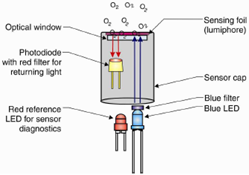
Accurate DO Measurement Leads to Efficient Plant Operations
Introduction
Dissolved Oxygen (DO) plays a major role in municipal wastewater treatment. Effectively monitoring DO in treatment processes, as well as in effluent waters, is extremely important for plant operations. Chemtrac offers a complete package for monitoring and controlling DO levels in most wastewater treatment applications.
Background
Maintaining target DO levels is crucial for the denitrification and phosphorus removal processes. The anaerobic conditions necessary for breaking down polyphosphates stresses the microorganisms. Moving between anoxic and oxic phases requires accurate and real time DO measurements for PLC controls. It all requires a constant balance of DO levels to keep the microorganisms working to produce a phosphate-rich sludge for disposal. So accurately monitoring DO is essential.
Traditional methods for the continuous measurement of DO include the use of polarographic sensors, galvanic sensors, and most recently, sensors utilizing optical technology based on luminescent quenching. Optical DO sensors have greatly improved the response time and signal stability, while decreasing the amount of routine maintenance. This technology also provides operators with the benefit of onboard diagnostics that routinely update to ensure that the optical sensor is measuring correctly.
Measurement

With the optical sensors, lumiphore molecules are excited by blue light, and then emit red light, which is detected by a photodiode. In the presence of oxygen, the lumiphore “blue light” is quenched and prevents the emission of red light. The sensors report DO concentrations in mg/L (ppm).
Wastewater Plant
The Town of Franklin Wastewater Treatment Plant, in Franklin, NC, utilizes an oxidation ditch equipped with rotary brushes to feed two secondary clarifiers.

Looking to minimize operating costs, and improve wastewater treatment efficiency, the plant installed dissolved oxygen sensors. Controls were set to turn on the rotary brushes at 0.5 ppm DO, and turn them off at 1.0 ppm. In doing so, the plant was able to reduce electrical costs, and optimize their phosphate removal. However, there were ultimately issues with maintaining the performance of those original DO sensors.
In July of 2021, Bill Deal, Operator in Responsible Charge at the plant, worked with John Rutledge, W.K. Hile Company Sales Representative, to demonstrate a new DO probe. A Chemtrac HydroACT controller was installed with an optical stainless steel DO sensor, a pH probe, and a total suspended solids sensor. During the course of the demo, the Chemtrac DO sensor proved to accurately track, and control, DO levels in the process.

In June of 2022, the Franklin plant decided to budget for Chemtrac DO monitors to replace their existing systems. In July, three HydroACT analyzers, each with an optical DO sensor, were installed to interface with the plant’s SCADA system. The DO readings are in turn used to control the rotary brush operations.
The plant operators appreciate the low maintenance requirements, and easy-to-navigate menus of their new DO monitoring systems. Sensor life expectancy is many years, with up to two years between simple lumiphore cap replacements and calibrations. So, over the life of the probes, there are significant savings with the Chemtrac monitors when compared to the competition.

